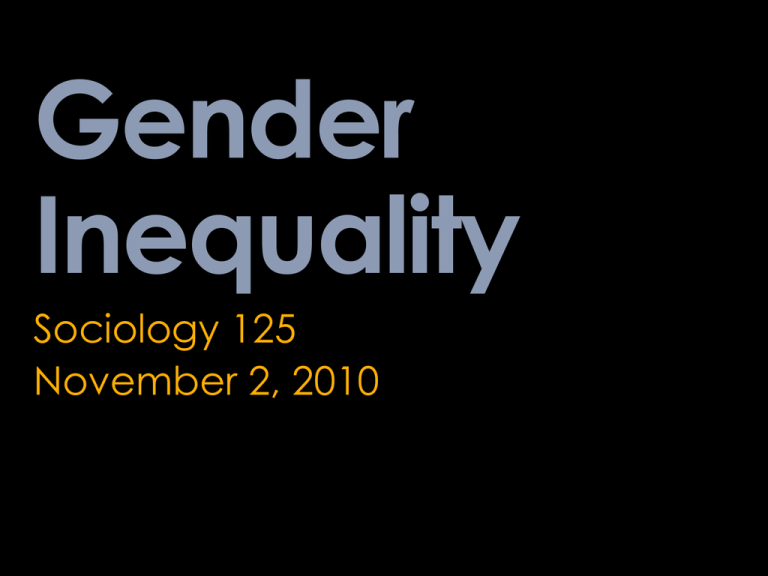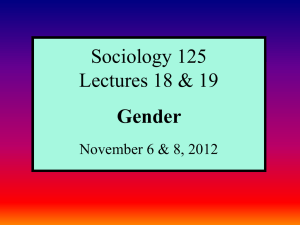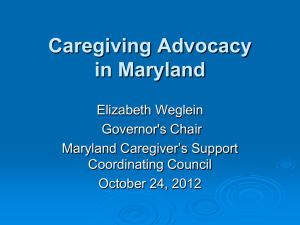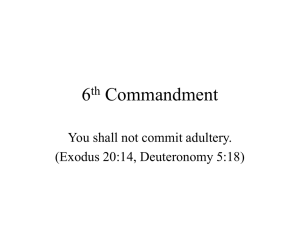
Gender
Inequality
Sociology 125
November 2, 2010
Films: November 3
Freedom on My Mind
http://newsreel.org/nav/title.asp?tc
=CN0037
This powerful documentary
chronicles the Mississippi Voter
Registration Project during the Civil
Rights movement of the early 1960s.
Archival footage and contemporary
interviews explore early efforts to
register disenfranchised blacks, the
Freedom Summer drive and the
formation of the Mississippi Freedom
Democratic Party. Freedom on My
Mind garnered a Best Documentary
Oscar nomination and won the
Grand Jury Prize at the Sundance
Film Festival.
Tulia, Texas
http://www.tuliatexasfilm.com/
The film documents an important episode
from the late 1990s and early 2000s in the
complicated racial history of Texas. The
episode made the news a few years ago
and quickly faded from our collective
memory. The filmmakers present a
balanced, if critical, view of the events in a
small town in the Texas panhandle and
what happened when a rouge undercover
cop arrested 46 people - 39 of whom were
African-Americans. The 46 people were
charged with selling drugs based solely on
the evidence of the single undercover cop.
While filmmakers clearly side with the
victims, they let the sheriff and the
undercover cop speak and they weave
together the different voices in the town to
present the narrative of the events fairly and
honestly. The connections between the fear
of drugs and racial prejudices are selfevident.
November 1 & 2
Growing Up Female
Killing us Softly
http://www.mediaed.org/cgibin/commerce.cgi?preadd=action&key=241
In this new, highly anticipated update of her
pioneering Killing Us Softly series, the first in more than
a decade, Jean Kilbourne takes a fresh look at how
advertising traffics in distorted and destructive ideals
of femininity. The film marshals a range of new print
and television advertisements to lay bare a stunning
pattern of damaging gender stereotypes -- images
and messages that too often reinforce unrealistic,
and unhealthy, perceptions of beauty, perfection,
and sexuality. By bringing Kilbourne's groundbreaking
analysis up to date, Killing Us Softly 4 stands to
challenge a new generation of students to take
advertising seriously, and to think critically about
popular culture and its relationship to sexism, eating
disorders, and gender violence.
http://www.newday.com/films/Growing_Up_Female.html
Growing Up Female is one of the first films of the modern
women's movement. Produced in 1971, it caused
controversy and exhilaration. It was widely used by
consciousness-raising groups to generate interest and help
explain feminism to a skeptical society. The film looks at
female socialization through a personal look into the lives
of six women, age 4 to 35, and the forces that shape them-teachers, counselors, advertising, music and the institution
of marriage. It offers us a chance to see how much has
changed--and how much remains the same. Purchased by
more than 400 universities and libraries.
Boys Will be Men
http://www.bullfrogfilms.com/catalog/boys.html
Boys are in trouble. The spate of school shootings in 1998 and 1999 amplified a warning being sounded by social
scientists. After 20 years of concern over the status of girls raised by the women's movement, some experts say it is
boys we need to turn our attention to. There are disturbing statistics to back this up. Four boys are diagnosed as
emotionally disturbed for every one girl. Six boys are diagnosed with attention deficit disorder for every one girl. Boys
kill themselves five times more often than girls. Boys are four times more likely to drop out of high school than girls
are. Girls now outnumber boys entering college.
How do boys become men? How do they learn courage, the difference between right and wrong, and the
meaning of love? What hurts them, makes them violent, and sometimes kills them? Boys Will Be Men, a
documentary film about growing up male in America, seeks answers to these questions.
Sex and Gender
Sex: a biological distinction based on roles in the
process of biological reproduction
Gender: a social distinction between roles and
expectations linked to sex.
Gender is the social transformation of a
biological difference, sex, into a social
difference.
Gender norms are the rules of appropriate
behavior and roles for men and women.
Justice
An inequality is unjust when:
a) the inequality is unfair,
and
b) something could in principle be done to
eliminate the unfairness.
Social injustices persist because of power
inequalities and the unwillingness of those with
power to make changes
What is Natural?
Biology and society:
Natural does not necessarily equal desirable or
unchangeable
Egalitarian gender relations = equal power and
autonomy
But not necessarily identical social roles
For instance, equality might mean equal amounts
of leisure time.
Is It possible to have a society within which deeply
egalitarian gender relations predominate?
What is Natural?
I. Existing distribution of
caregiving in a world with
strong gender norms
# of people
Gender gap in
caregiving
Men
Low
Women
High
The intensity of caregiving behavior
(hours/week dedicated to child care)
What is Natural?
I. Existing distribution of
caregiving in a world with
strong gender norms
II. Hypothetical distributions of
caregiving in a world with
weak gender norms
Gender gap in
caregiving
Gender gap in
caregiving
Men
Low
Men
Women
High
The intensity of caregiving behavior
Low
Women
High
The intensity of caregiving behavior
Massive Transformation in
Gender Relations
Legal Rights
Labor Force Participation
Occupation Structure and Earnings
Political power
Transformation in Family Structure
Domestic Division of Labor
Sexuality
Legal Rights gained by women
Right to vote (1920; 19th Amendment)
Right to own passport (early 1930s)
Equal right to divorce (gradually since 1940s)
Reproductive rights (1973)
Equal rights to university admission (1960s)
Equal rights to all jobs and equal pay (1960s)
Equal rights to participate in sports (1972)
Paid Work: the new cultural norm
Labor Force Participation Rates
of Married Women with Children, 1950-2007
Occupational Structure and Earnings
% Enrollments in Medical & Law Schools who are women, 1949-2007
60%
50%
40%
30%
20%
10%
0%
1949-'50
1959-'60 1969-1970 1979-'80
Medical School
1989-'90
Law School
1999-'00
2006-'07
Some jobs remain highly
gendered
Men’s and Women’s median wages, 1973-2004
$18
Women’s wages =
63% of men’s wages
Women’s wages =
82% of men’s wages
$16
$14
$12
$10
men
women
$8
$6
$4
$2
$0
1973
1979
1989
1995
2000
2005
Occupational Structure and
Earnings
http://www.clevelandfed.org/research/trends/2007/1207/01ecoact.cfm
http://www.nytimes.com/interactive/2009/03/01/business/20090301_WageGap.html?8dpc
Educational Attainment
Educational Earnings Gap
In 2001, women with a Doctorate earned 75% of what men
with identical educational attainment earned
What Explains the Gender Pay
Gap?
Today, human capital differences (education, workplace
experience), as well as race (another pay gap), explain less
of the wage gap.
Unexplained pay gap is between 9 and 17%. Is this the result
of discrimination?
Aggregate data don’t say conclusively audit studies are
suggestive of discrimination
Reflect earnings between gendered jobs: stereotypical
women’s jobs pay less on average.
Discrimination alters incentives: who should drop out of the
labor market at childbirth?
if her expected earnings are lower, perhaps the woman. If
so, this would exacerbate the pay gap but in a way not
easily detected as discrimination
% of corporate officers and CEOs who are women
18.0%
16.0%
14.0%
corporate officers
in largest 500 firms
12.0%
10.0%
8.0%
6.0%
4.0%
CEOs in largest 1000 firms
0.0%
1972
1973
1974
1975
1976
1977
1978
1979
1980
1981
1982
1983
1984
1985
1986
1987
1988
1989
1990
1991
1992
1993
1994
1995
1996
1997
1998
1999
2000
2001
2002
2003
2004
2005
2006
2007
2008
2.0%
Women elected officials, 1979-2009
Women in national legislatures, 2009 (%)
50%
45%
40%
35%
30%
25%
20%
15%
10%
5%
0%
Political and Economic Power
Transformation of Family Structure:
Heterogeneous families
Probability of
divorce has
increased from
12% (1950’s) to
~50% (2002)
Average age of
first marriage
delayed (26 for
women, 27 for
men)
% of Households that consist of a Married Couple
90%
80%
76.0%
78.2%
74.3%
70.5%
70%
62.1%
60%
56.0%
52.8%
50%
50.0%
40%
30%
20%
10%
0%
1940
1950
1960
1970
1980
1990
2000
2008
% of Households that consist
of a Single Person living alone
30%
28%
25%
20%
18%
15%
10%
8%
5%
0%
1940
1970
2008
% of Women ages 30-34
who have Never Married, 1940-2000
30%
27.3%
25%
21.8%
20%
15%
17.7%
14.3%
10.5%
9.0%
10%
6.9%
7.5%
1960
1970
5%
0%
1940
1950
1980
1990
2000
2007
Probability of first marriage disruption within 10 years by marriage
cohort and race/ethnicity: marriages begun 1954-1984
Domestic Division of Labor
Decision making in the household
A Pew Research Center
survey (2008) asked men
and women living in
couples which one
generally makes the
decisions in four familiar
areas of domestic life:
Who decides what you
do together on the
weekend? Who manages
the household finances?
Who makes the decisions
on big purchases for the
home? And who most
often decides what to
watch on television?
House cleaning
20
18
Ratio
23.3:1
Hours per week
16
14
Ratio
13.5:1
12
10
Ratio
4.4:1
8
6
4
2
0
1965
mothers
1975
2005
fathers
Time devoted by Mothers and Fathers to routine housecleaning
Men have taken on
modestly more
amounts of
domestic labor
Women’s domestic
labor has declined
modestly overall,
while simultaneously
joining the paid
labor force
Sexuality
Sexuality and gender relations:
Sexuality is governed by rules and norms
Policing rules about sexuality impacts gender equality
rules change over time and have been impacted by
birth control, social movements, and formal laws
Control over sexuality and unequal power relations
Sexual Violence
Laws and norms around sexual harassment
De-criminalization and partial de-stigmatization of
homosexuality
Sexual Violence
http://articles.sfgate.com/2006-0904/news/17310748_1_sexual-harassmentharassment-cases-harassment-claims
% Endorsing Same-Sex Marriage
60%
50%
40%
30%
20%
10%
0%
1996 1998 1999 2000 2002 2003 2004 2005 2006 2009
Summary
Significant erosion of male domination and
substantial increases in autonomy and selfdetermination for women
Gender inequality remains
What explains the transformation of
gender relations?
Explaining Changes in Gender
Relations
Women have always tried to increase their
autonomy and reduce their subjection. But
throughout most of history these struggles have
produced at best minimal change.
Why do these struggles produce big changes
sometimes and not others? Why in second half
of the 20th century was there such massive
transformation?
The general answer
While women have tried throughout history to
increase their autonomy and reduce their
subordination, they could only succeed in doing
this on a large scale once social conditions had
changed in ways that made existing gender
power relations fragile.
Three basic processes
1. Decline in a coherent interest among men to
defend male domination
2. Erosion of institutional system of female
domesticity which eroded women’s interest
in traditional gender relations
3. Increase in capacity for challenge by
women
The decline of coherent male
interests in male domination
Central explanation:
The rapidly increasing economic demand for literate labor
by male employers
Crisis of female domesticity
• Stable marriage/personal relations fostered
domesticity
• blocked work opportunities increased the
attractiveness of domesticity
• A family wage made domesticity economically
feasible
• dense social networks supported domesticity
(neighbors, churches, communities, etc.)
• cultural norms and sexism reinforced identities and
expectations
Collapse of the system of
coherent domesticity beginning
in the 1960s
decline of stable marriage means women cannot
count of support of husbands
expansion of work opportunities increased the
viability of alternatives to domesticity
decline of the family wage made domesticity
economically difficult decline of unions and deregulation of labor markets
erosion of dense social networks makes
domesticity more isolated and difficult
challenge to cultural norms and traditional sexism
contributes to new identities
increasing abilities of women to
struggle against oppression
Members of the Political Equality
League stump for women’s suffrage
in Milwaukee in an early Ford
(~1911-12)
Gender relations today
Dramatic decline in family size unlikely to be reversed:
permanent erosion of lifetime domesticity as an ideal
Traditional marriage stability unlikely to be restored
women’s labor force participation unlikely to be
reversed
women’s participation in powerful and influential
positions unlikely to decline
How much further can we go in eliminating remaining
forms of gender inequality?
Imagine two possible worlds
World #1
World #2
• Average wages of men and women
are about the same
• Good quality childcare is provided by
the city or employers free or at low cost
• Generous paid parental leave for
caregiving emergencies and early infant
care
• Average wages of women are 75-80%
of wages of men
• No childcare is provided by the city or
employers; private daycare is expensive
or of poor quality
• no paid parental leave for caregiving
emergencies or early infant care
World #1 is like Sweden
World #2 is like the United States
Gains and Losses
Gender equality imposes costs on some women and
erodes some of the security that comes with
traditional female dependency.
Certain ways of life, valued by many women and
men, are threatened by gender equality.
Men have contradictory interests with respect to
gender inequality: men have much to gain from
gender equality, but some losses as well.
Gains for men: opening up of choices around
parenting & work; the cult of masculinity blocks the
full development of personhood in men.
Losses for men: more competition for higher paying
jobs; end of gender-based privileges at home.
Gendered Division of labor in the
Household
Distribution of free time
Implications for employment
penalties for leaving the labor market
Limitations in types of jobs available to married
women
Employer expectations about women
Policy Options
1.
Pay equity
not just equal pay for identical work, but equal pay
for comparable work – jobs with similar skill sets would
be paid the same.
would make feminine jobs more attractive to men,
because the pay would be higher, thus leading to
occupational equality.
Would contribute to equalizing wages between men
and women and thus alter the gender dynamics of
household work
High quality publicly provided childcare
Egalitarian parental leave
Sources of Child Care
Parental Leave
The Family Ideals and Fallback Positions of
Young Men and Women
90%
80%
70%
60%
50%
40%
30%
20%
10%
0%
Women's ideals
Egalitarian family ideal
Men's ideals
Women's fallback
position
Neo-traditional family ideal
Men's fallback
position
Self-reliant family ideal











